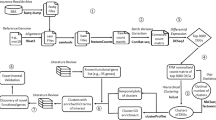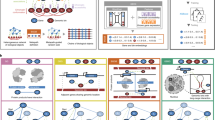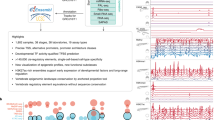Key Points
-
The concept of a bioinformatic framework is exemplified by sequence databases. DNA sequences provide a one-dimensional framework to which additional information concerning structure and function can be added.
-
Additional frameworks are being developed, such as controlled vocabularies and ontologies, so that information about gene expression and function can be indexed and compared between experiments and between organisms.
-
Frameworks are being developed at many levels of biological organization, such as gene sequence, protein structure, metabolic pathway and organism.
-
Organism-level frameworks are essential for comparison of gene expression and function in development. Such frameworks can be textual or can be digital spatio-temporal models of development.
-
One such framework is being constructed by the Edinburgh Mouse Atlas Project (EMAP). Additional frameworks are being developed in other model systems, such as zebrafish.
-
EMAP at present provides a reference framework to identify and name parts of the embryo, and a framework to which gene expression data can be mapped. This allows comparisons to be made between gene expression patterns.
-
Future goals of this work will be to map other types of data, such as phenotypic data on mouse mutants, and to integrate data with similar frameworks in other model systems.
Abstract
The spatio-temporal expression pattern of a gene during development is a valuable piece of information. But there is no way to compare precisely the patterns of expression of different genes, or the way the patterns are changed in a mutant. One way to solve this problem is to construct digital reference images of development (a bioinformatics framework), to which expression patterns can be mapped and stored, then compared. Such frameworks are under active development in several model systems. They will form the basis of powerful and integrated gene expression databases, which facilitate comparisons between genes, tissues and species.
This is a preview of subscription content, access via your institution
Access options
Subscribe to this journal
Receive 12 print issues and online access
$189.00 per year
only $15.75 per issue
Buy this article
- Purchase on Springer Link
- Instant access to full article PDF
Prices may be subject to local taxes which are calculated during checkout







Similar content being viewed by others
References
Nadeau, J. H. Muta-genetics or muta-genomics: the feasibility of large-scale mutagenesis and phenotyping programs. Mamm. Genome 11, 603–607 (2000).A thoughtful and provocative discussion of systematic approaches to capturing gene function data at the organism level.
Paigen, K. & Eppig, J. T. A mouse phenome project. Mamm. Genome 11, 715–717 (2000).
Bray, D. Reductionism for biochemists: how to survive the protein jungle. Trends Biochem. Sci. 22, 325–326 ( 1997).
Achard, F., Vaysseix, G. & Barillot, E. XML, bioinformatics and data integration. Bioinformatics 17, 115–125 (2001).
The Gene Ontology Consortium. Gene Ontology: tool for the unification of biology. Nature Genet. 25, 25–29 (2000).Gene Ontology is an excellent example of a dynamic bioinformatic framework that aims to unify our understanding of gene function across species and different levels of biological organization.
Streicher, J. et al. Computer-based three-dimensional visualization of developmental gene expression. Nature Genet. 25, 147– 152 (2000).
Hecksher-Sorensen, J. & Sharpe, J. 3D confocal reconstruction of gene expression in mouse. Mech. Dev. 100, 59–63 (2001).
Ringwald, M., Eppig, J. T., Kadin, J. A., Richardson, J. E. & the Gene Expression Database Group. GXD: a gene expression database for the laboratory mouse: current status and recent enhancements. Nucleic Acids Res. 28, 115–119 (2000).
Lester, H. & Arridge, S. R. A survey of hierarchical non-linear medical image registration. Pattern Recognition 32, 129–149 (1999).
Toga, A. W. & Thompson, P. M. The role of image registration in brain mapping. Image Vision Comput. 19, 3–24 (2001).
Baldock, R., Bard, J., Kaufman, M. H. & Davidson, D. A real mouse for your computer. BioEssays 14, 501– 502 (1992).
Brune, R. M. et al. A three-dimensional model of the mouse at embryonic day 9 . Dev. Biol. 216, 457–468 (1999).
Bard, J. et al. An internet-accessible database of mouse developmental anatomy based on a systematic nomenclature. Mech. Dev. 74, 111–120 (1998).
Theiler, K. The House Mouse. Atlas of Embryonic Development (Springer, New York, 1989).
Kaufman, M. H. The Atlas of Mouse Development (Academic, London, 1992 ).
Davidson, D., Bard, J., Kaufman, M. H. & Baldock, R. The Mouse Atlas Database: a community resource for mouse development. Trends Genet. 17, 49–51 ( 2001).
Louie, A. Y. et al. In vivo visualization of gene expression using magnetic resonance imaging. Nat. Biotechnol. 18, 321–325 (2000).
Verbeek, F. J. et al. A standard atlas of zebrafish development for projection of experimental data. Proc. Int. Soc. Opt. Engng 3964, 242–252 (2000).
Hartenstein, V., Lee, A. & Toga, A. W. A graphical digital database of Drosophila embryogenesis . Trends Genet. 11, 51– 58 (1995).An excellent discussion of the issues involved in building an atlas database framework for Drosophila .
Toga, A. W. Brain Warping (Academic, San Diego, 1999). A collection of authoritative papers on methods to combine and compare three-dimensional images of mammalian brains.
Toga, A. W. & Thompson, P. in Brain Warping (ed. Toga, A. W.) 1–26 (Academic, San Diego, 1999).
Toga, A. W., Santori, E. M., Hazani, R. & Ambach, K. A digital map of rat brain. Brain Res. Bull. 38, 77–85 (1995).
Raff, R. A. Evo-devo: the evolution of a new discipline. Nature Rev. Genet. 1, 74–79 (2000 ).
Davidson, D. et al. in In situ Hybridization, a Practical Approach (ed. Wilkinson, D.) 190–214 (IRL, Oxford, 1998).
Drysdale, R. Phenotypic data in FlyBase. Briefings Bioinform. 2, 68–80 (2001).A good, practical description of how FlyBase addresses the problems of describing mutant phenotype in a bioinformatic context.
Eppig, J. T. Algorithms for mutant sorting. Mamm. Genome 11, 584–589 (2001).A discussion of work to incorporate phenotypic descriptors into the textual bioinformatics framework for the mouse. Compare with reference 25.
Ringwald, M. et al. A database for mouse development. Science 265, 2033–2034 (1994).
Allen, J. F. Maintaining knowledge about temporal intervals. Commun. Assoc. Comput. Machin. 26, 832–843 (1983).
Vidal, M. A biological atlas of functional maps. Cell 104, 333–339 (2001).
van Helden, J. et al. Biological function from the network of molecules and interactions . Briefings Bioinform. 2, 81– 93 (2001).
Karp, P. D. An ontology for biological function based on molecular interactions. Bioinformatics 16, 269–285 (2000).
Rzhetsky, A. et al. A knowledge model for analysis and simulation of regulatory networks. Bioinformatics 16, 1120– 1128 (2000).
Hillis, D. M. & Holder, M. T. in New Technologies for Life Sciences: a Trends Guide (ed. Wood, R.) 47–50 (Elsevier Science, London, 2000).
Tomita, M. et al. E-CELL: software environment for whole-cell simulation. Bioinformatics 15, 72–84 (1999).
von Dassow, G., Meir, E., Munro, E. & Odell, G. M. The segment polarity network is a robust developmental module. Nature 406 , 188–192 (2000).
The FlyBase Consortium. The FlyBase Database of the Drosophila Genome Projects and community literature. Nucleic Acids Res. 27, 85–88 (1999).
Stein, L., Sternberg, P., Durbin, R., Theirry-Mieg, J. & Spieth, J. WormBase: network access to the genome and biology of Caenorhabditis elegans. Nucleic Acids Res. 29, 82–86 ( 2001).
Sulston, J. E., Scherienberg, E., White, J. G. & Thomson, J. N. The embryonic cell lineage of the nematode Caenorhabditis elegans. Dev. Biol. 100, 64–119 ( 1983).
Campos-Ortega, J. A. & Hartenstein, V. The Embryonic Development of Drosophila melanogaster (Springer, Berlin, 1985).
Nieuwkoop, P. D. & Faber, J. Normal Table of Xenopus laevis (North Holland, Amsterdam, 1967 ).
Kimmel, C. B., Ballard, W. W., Kimmel, S. R., Ullmann, B. & Schilling, T. F. Stages of embryonic development of the zebrafish. Dev. Dyn 203, 253– 310 (1995).
Hamburger, V. & Hamilton, H. L. A series of normal stages in the development of the chick embryo. J. Morphol. 88 , 49–93 (1951).
Downes, K. M. & Davies, T. Staging of gastrulating mouse embryos by morphological landmarks in the dissecting microscope. Development 118, 1255–1266 ( 1993).
O'Rahilly, R. & Muller, F. Developmental Stages in Human Embryos Including a Revision of Streeter's 'Horizons' and a Survey of the Carnegie Collection (Carnegie Institute, Washington DC, 1987 ).
Anonymous. Nomina Anatomica, Nomina Histologica, Nomina Embryologica (Churchill Livingston, Edinburgh, 1992).
Acknowledgements
The Edinburgh Mouse Atlas Project (EMAP) is a collaboration between D.D. and R.B. at the MRC Human Genetics Unit and M. Kaufman and J. Bard at the Department of Biomedical Sciences, University of Edinburgh. EMAP has been advised by networks with grants from the European Science Foundation and the Wellcome Trust. We thank the FlyBase and the WormBase consortiums for permission to use material from these databases and V. Hartenstein, R. Jacobs, F. Verbeek and T. Strachan for sharing information about work in progress.
Author information
Authors and Affiliations
Supplementary information
Three-dimensional model of mouse stage 12 embryo.
Model embryos in the EMAP Atlas can be viewed in section or as three-dimensional movies that highlight particular anatomical structures to show their spatial relationships and developmental changes. This movie shows a Theiler stage 12 embryo (embryonic day (E)8.0). Two tissues have been highlighted; the remaining tissue domains and the underlying histological structure are hidden from view (orange, neural tissue; translucent, surface ectoderm).
Three-dimensional model of mouse stage 13 embryo.
Model embryos in the EMAP Atlas can be viewed in section or as three-dimensional movies that highlight particular anatomical structures to show their spatial relationships and developmental changes. This movie shows a Theiler stage 13 embryo (E8.5). Two tissues have been highlighted; the remaining tissue domains and the underlying histological structure are hidden from view (orange, neural tissue; translucent, surface ectoderm).
Related links
Related links
DATABASE LINKS
FURTHER INFORMATION
Mouse Genome Informatics Database
Mouse Genome Informatics Gene Expression Database
The Edinburgh Mouse Atlas Project
The Multidimensional Human Embryo
Brain Molecular Anatomy Project
Two-dimensional images of parts of the fly
Dysmorphic Human–Mouse Homology Database
The Mouse Gene Expression Information Resource
CATH — Protein Structure Classification
KEGG — Kyoto Encyclopedia of Genes and Genomes
EcoCyc — Encyclopedia of E. coli Genes and Metabolism
The stages of Xenopus embryonic development
Glossary
- CONTROLLED VOCABULARY
-
A list of permitted terms that can be used to describe data: for example, radius, forelimb and bone.
- ONTOLOGY
-
A collection of terms that describe concepts, entities and their relationships: for example, the 'radius' is part of the 'forelimb' or the 'radius' is an instance of 'bone'.
- DIRECTED ACYCLIC GRAPH
-
A graph of relationships between objects in which any object can have more than one parent, each link is directional and cyclical relationships are prohibited.
- THEILER STAGE
-
Stages of development of the mouse embryo determined by particular developmental events: for example, eye closure or appearance of digits.
- XML FORMAT
-
The eXtensible Markup Language (XML) is related to HyperText Markup Language (HTML) and is an emerging standard for structuring documents.
- OBJECT-ORIENTATED
-
The term used to describe a programming design in which all data are regarded as parts of objects that hold both the data and the procedures or methods that can be applied to that data. This encapsulation enforces good programming practice and makes code more portable.
- CORBA
-
Common object request broker architecture is an industrial standard protocol for making objects, both data and methods, accessible over the Internet for remote access and invocation. If a database provides a CORBA interface then it is CORBA-compliant.
- JAVA
-
An object-orientated language developed by Sun Microsystems that has become a standard for programs delivered as part of World Wide Web documents.
- VOXEL
-
A digital image is represented as an array of image values, either as a grey-level or colour. A voxel is the term for one value in a three-dimensional array for a three-dimensional image.
- MORPHOMETRIC
-
A measure of shape.
Rights and permissions
About this article
Cite this article
Davidson, D., Baldock, R. Bioinformatics beyond sequence: mapping gene function in the embryo . Nat Rev Genet 2, 409–417 (2001). https://doi.org/10.1038/35076500
Issue Date:
DOI: https://doi.org/10.1038/35076500
This article is cited by
-
eMouseAtlas informatics: embryo atlas and gene expression database
Mammalian Genome (2015)
-
Integrating partonomic hierarchies in anatomy ontologies
BMC Bioinformatics (2004)
-
Something old, something new
Nature Genetics (2001)



